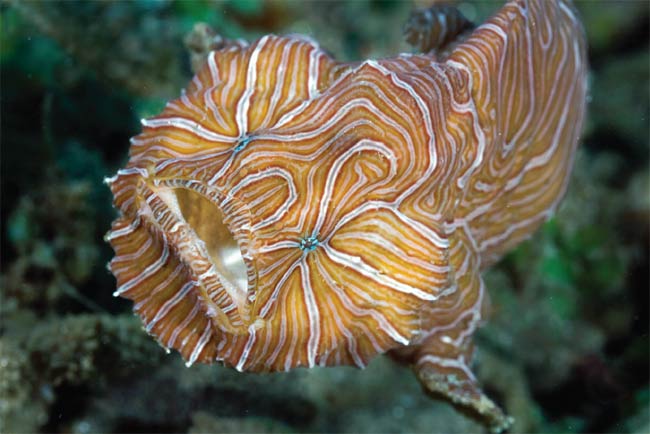Freaky Fish Has Eyes Like Ours

Most fish have eyes on the sides of their heads, but a scientist now has confirmed a new and elusive species of carnivorous frogfish with eyes that face forward, like ours. The creature also has a fleshy chin and cheeks, adding to its strange appearance.
The bizarre new species, Histiophryne psychedelica, made a brief splash a year ago when sport divers about 30 feet offshore of Ambon Island, Indonesia, photographed a shallow-water fish not seen before in 20 years of diving there.
Ichthyologist Ted Pietsch of the University of Washington's Burke Museum of Natural History and Culture received pictures of the fish and guessed it belonged to the Histiophryne genus. Now he has confirmed this using genetic and morphological data, and fully described the freaky fish as a new species.
"It is just an absolutely fantastic example of what natural selection can produce," Pietsch told LiveScience. "And it's a fantastic organism in its own right, and that is certainly enough to make it important."
Pietsch's description of the animal, partly supported by the National Science Foundation, is detailed in the journal Copeia.
Other weird things about the fish
The fish is quite a sight: its extremely gelatinous skin is very fleshy, thick and loose; and the skin is covered with white stripes radiating from the eyes and continuing back to the body. This pigmentation could help the fish blend in among colorful, venomous corals on the sea floor in the area.
Sign up for the Live Science daily newsletter now
Get the world’s most fascinating discoveries delivered straight to your inbox.
"The Psychedelic Frogfish probably joins the long list of dishonest and harmless animals that have evolved to mimic the beauty of venomous animals," said Leo Smith, assistant curator of fishes at The Field Museum in Chicago. "Pietsch and colleagues nailed this when they suggested that it looked just like the venomous corals found in its environment."
The fish also has some plastic abilities.
"This animal seems to have ability to flare its face out and then pull it back again, so when it comes through a small crevice, those eyes become lateral and then it flares its eyes out," Pietsch said. "It's also probably a threat display — when it shows that oval face with the psychedelic striping, you think that'd scare something away."
The fish might have sensory structures along the outer margin of its face that would have a protective function like cat whiskers to enable it to sense the internal walls of a little cavern or a little space between coral, he said. Other fishes with forward-facing eyes include monkfishes and goosefishes.
The fish's jaws are lined with two to four irregular rows of small teeth, which it uses to consume smaller fish, shrimp and other marine life.
The fish tend to hang out in pairs, and are often so well hidden that they could only be found when divers looked under rubble on the seafloor. Once uncovered, the fish immediately tried to wriggle out of sight by entering a crevice or hole via rigorous twisting and turning of the body and use of its pelvic fins to manipulate its position, like we would use our hands. Yet the fish later show no signs of damage.
The fish get around in the sea via jet propulsion, or forcefully expelling water through openings in the body. The specimen that Pietsch studied was collected by his graduate student Rachel Arnold and photographed by David Hall.
Mysterious origins
People have been diving intensively in this region for more than 20 years, yet the new species was only noticed, near Ambon Island, last year by employees of Maluku Divers. In June 1992, staff at the Dallas Aquarium also noticed two frogfish with an unusual pigment pattern, found in a shipment of live fishes from Bali, Indonesia, but no one had time to examine them for years.
So, it's a mystery as to where the fish came from, Pietsch said. It could have been living for years in deeper waters, and then come into shallower waters recently for some oceanographic reason in the last season.
"It seems that some of these animals do a bit of moving up and down into deeper water," he said. "We know they come up in shallow water to spawn and reproduce, but that cycle should've been noticed in past years and it really wasn't."
Many animals with brilliant pigmentation, like the new frogfish species, are toxic. The colors warn other animals not to eat them. However, there is no toxicity ever recorded with this group of animals, Pietsch said.
"Although this doesn't mean this thing doesn't have toxicity on its skin," he said. "A test is easy enough to do. You just touch your finger to it and then touch your finger to tongue. You get a burning sensation. I would do it in a minute."
Sadly, Pietsch has no access to specimens for now.
- Video: Freaky-Faced Fish Squirts Along in Indonesian Waters
- Gallery: Venomous Fish
- Gallery: Freaky Fish
Robin Lloyd was a senior editor at Space.com and Live Science from 2007 to 2009. She holds a B.A. degree in sociology from Smith College and a Ph.D. and M.A. degree in sociology from the University of California at Santa Barbara. She is currently a freelance science writer based in New York City and a contributing editor at Scientific American, as well as an adjunct professor at New York University's Science, Health and Environmental Reporting Program.










